Pastéis de Nata (Portuguese Custard Tarts)
This post may contain affiliate links. See my disclosure policy.
A thoroughly traditional Pastéis de Nata recipe. Crispy-crunchy pastry crust with a smooth and creamy custard filling is what awaits your bite into these traditional, world famous sweet custard tarts from Lisbon, Portugal!
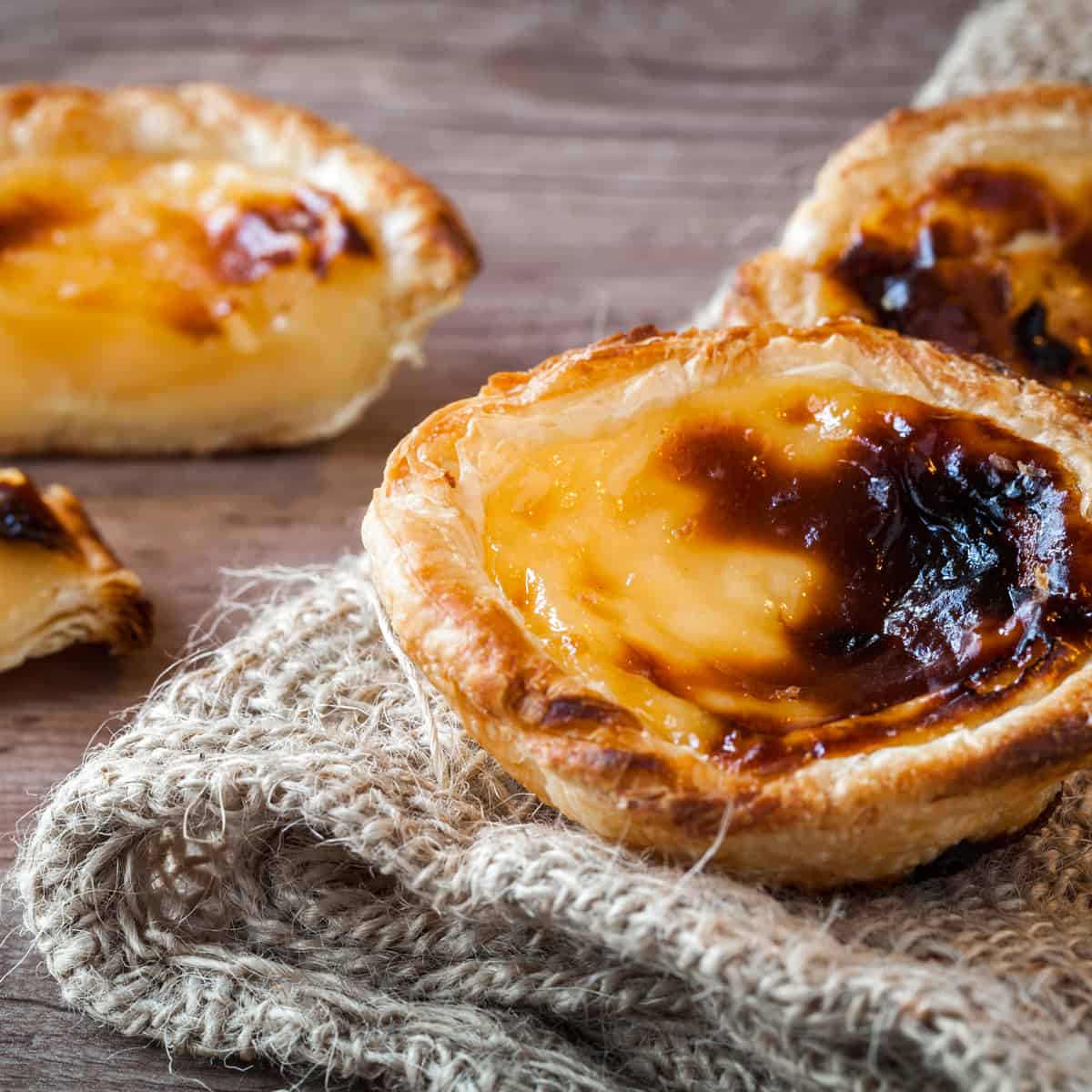
On our most recent trip to Lisbon, Portugal we made it a point to sample (as many as we could fit!) the city’s famous pastry that The Guardian designated as among the world’s “50 best things to eat.” Today I’m sharing with you how to make the perfect pastel de nata with the finest texture and best balance of flavors.
What are Pastéis de Nata?
A pastel de nata is a Portuguese custard tart made with puff pastry and filled with egg custard that is served with a dusting of powdered sugar and a pinch of cinnamon. The tarts are baked at a blazingly hot temperature until the tops are scorched.
Some people also refer to them as Pastéis de Belém (pastries of Bethlehem) but that name is a patented one and refers strictly to the pastries made in that specific bakery. The pastry was created sometime prior to the 18th century by Catholic monks of the Jerónimos Monastery. The monastery closed in 1834 and the recipe was sold to a sugar refinery whose owners opened the bakery, the Fábrica de Pastéis de Belém in Lisbon, in 1837. It is still operated by the original family’s descendants today.
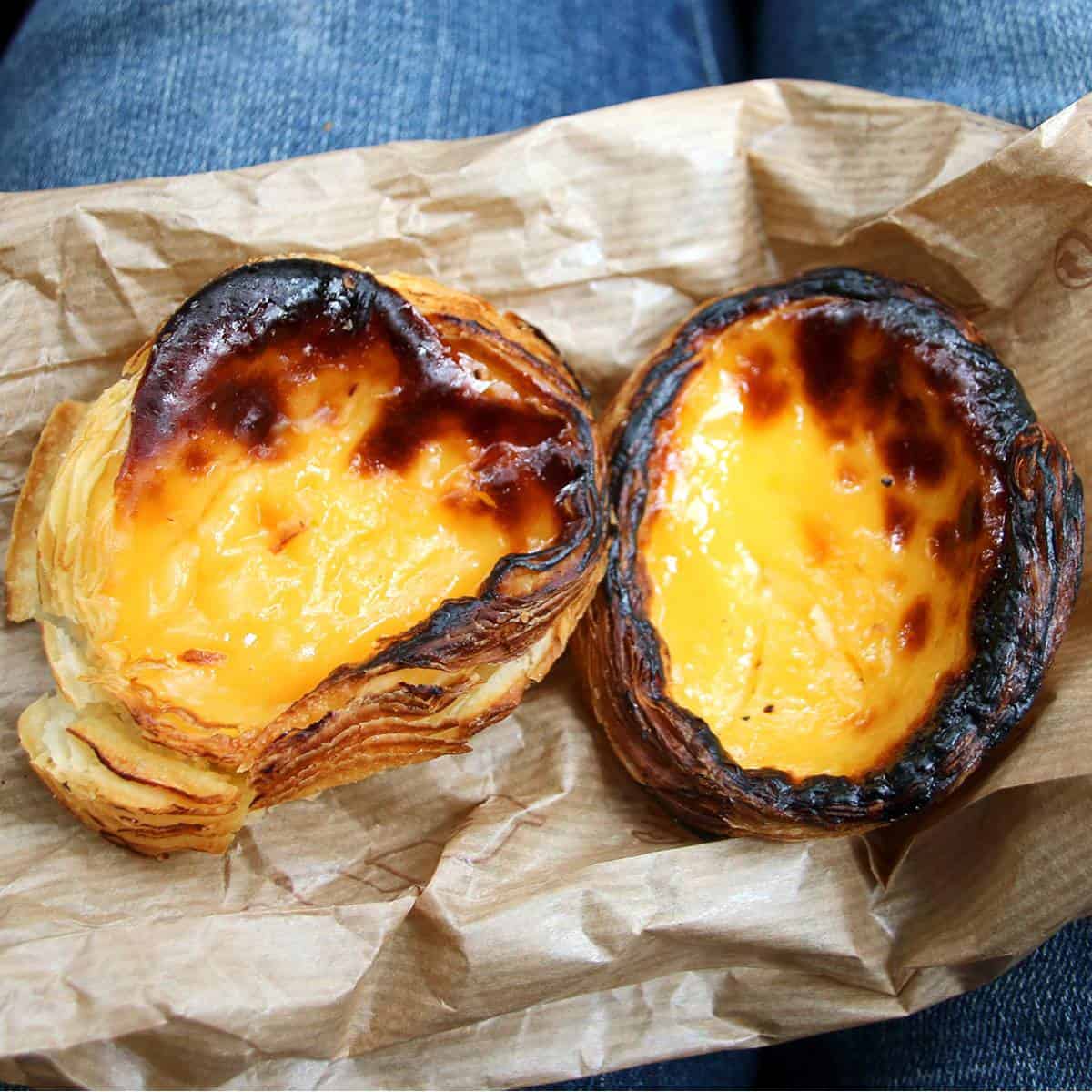
Can You Freeze Them?
Yes and no….mostly no. You can freeze them in an airtight container or in freezer bags for up to 3 months, however they don’t thaw well. Like most products with dairy, the fats and water thaw at different rates leaving you with soggy pastry crust and custard that has split. So while you can freeze them if you find you have more than you can eat, just know that the texture won’t be nearly as good as freshly baked.
How Long Do They Keep?
Pasteis de Nata are best eaten warm (or cold) the same day they are baked. However you can store them at room temperature in an airtight container for up to two days.
How To Serve Pastéis de Nata
These pastries are commonly served with a dusting of powdered sugar, cinnamon, or both. Some bakeries serve them with neither. They’re best enjoyed warm within a few hours of baking when the pastry is nice and crispy and the custard is delicately smooth and creamy.
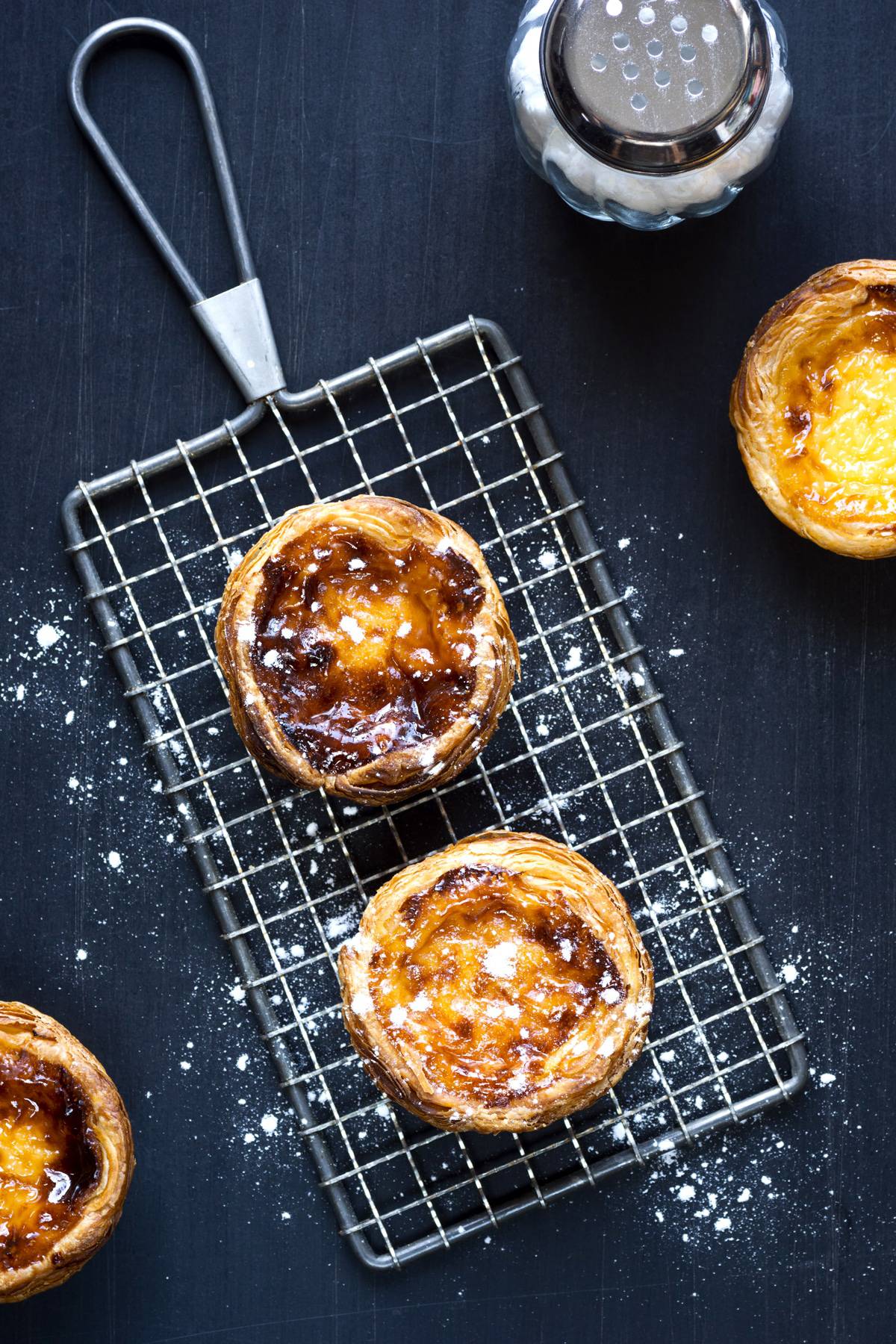
Pastéis de Nata Recipe
Let’s get started!
Make the Custard:
Place the water, sugar, cinnamon and lemon rind in a medium saucepan and bring it to a boil. Reduce the heat to medium and let it simmer – without stirring – until it reachers 220 degrees F on an instant read thermometer.
Remove from the heat and let it cool for at least 15 minutes while you prepare the rest of the ingredients.

In a separate medium saucepan scald the milk (heat until up to the boiling point but don’t let it boil). Turn off the heat and add the flour and salt to the hot milk and whisk constantly until the mixture is nice and thick.

Add the egg yolks and whisk until combined.
Whisk in the vanilla extract.

Remove the cinnamon and lemon rind.
In a thin, steady stream pour the syrup into the egg/flour mixture, whisking constantly.
The custard will be very thin, this is normal.

Pour the custard through a fine mesh sieve to strain out any chunky bits.
Cover the bowl with plastic wrap and set aside until ready to use. You can make this in advance and refrigerate for up to 3 days.

Prepare the Pastry Dough:
On a lightly floured work surface, roll the pastry dough out to roughly a 11×14 inch rectangle.
Beginning at the short end, roll up the pastry dough, rolling it tightly as you go along.

Wrap the pastry roll in plastic wrap and refrigerate for at least 2 hours.

Assemble the Tarts:
Preheat the oven to the highest temperature it will go (I heated mine to 525 degrees F).
Use a pastry cutter or sharp knife to cut the pastry log into about 3/4 inch thick rounds. (Cut a thin layer off each end and discard.)
Those lovely layers are going to make your tart pastry beautifully crisp and flaky.

Use a standard size non-stick muffin pan (I love my USA Pan muffin pan). Depending on how full you fill the tarts this recipe makes about 16 tarts so you may need a second muffin pan.
Place a pastry round in each tin. Use your thumbs to press the pastry down and up the sides to the very top to fit the mold.

Now it’s time to fill the tarts!
Pour the prepared custard into each pastry case to about 3/4 of the way full. Don’t fill them too full or the custard will overflow onto the rims of the tart crusts.

Place the pan on the middle rack of the preheated oven.
Depending on the max temperature of your oven, bake for about 14-16 minutes (my temperature was set to 525 degrees F). You’ll know the tarts are done when the tops are nicely scorched and the filling is set. The filling will initially puff up while baking but once the pan is removed the filling will sink back down.
Remove from the oven and let the tarts cool for about 8-10 minutes before removing them.
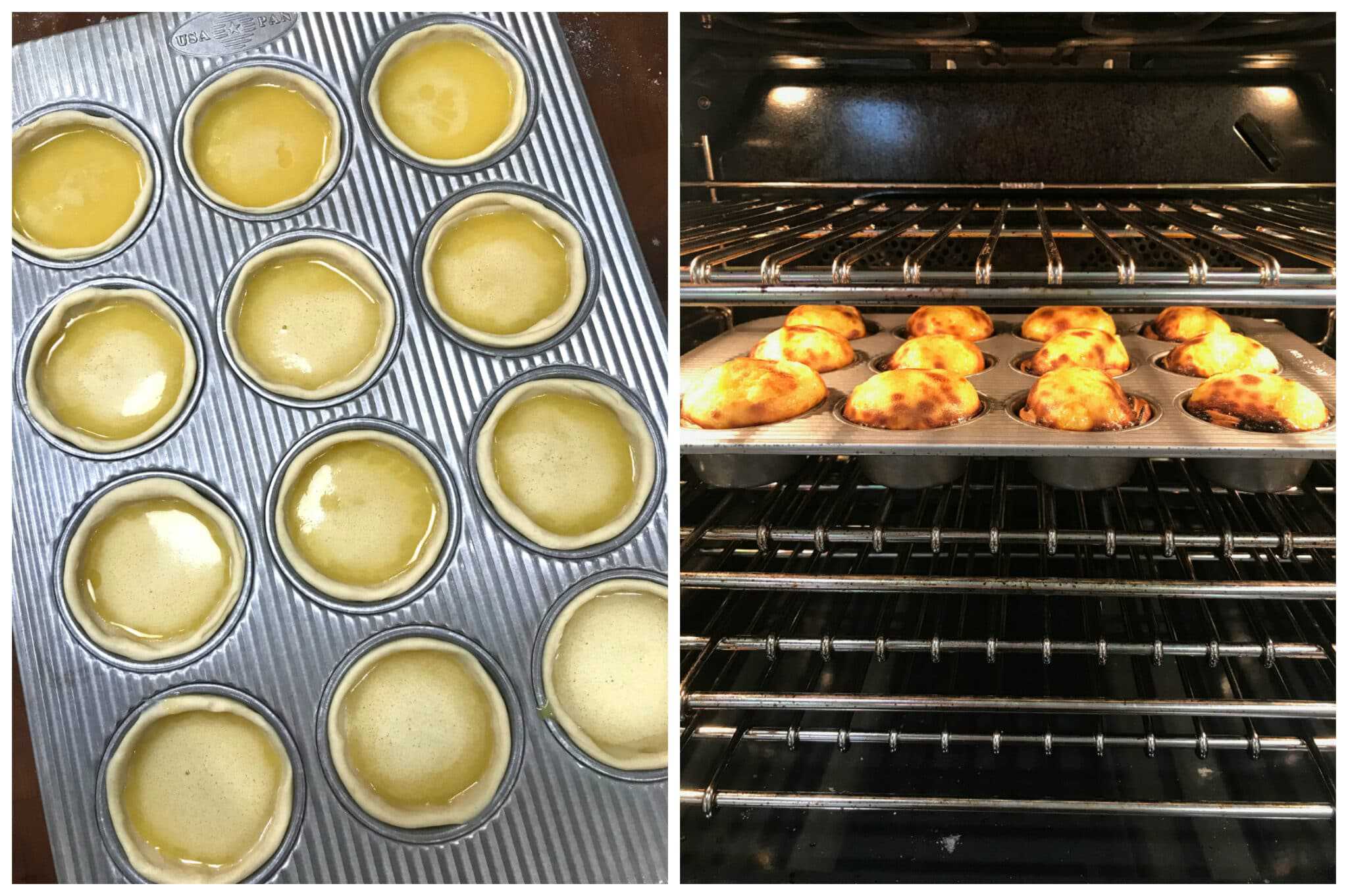
Serve with a dusting of powdered sugar and a small pinch of cinnamon if desired.
These pastries are best eaten warm the same day they are baked.
Enjoy!
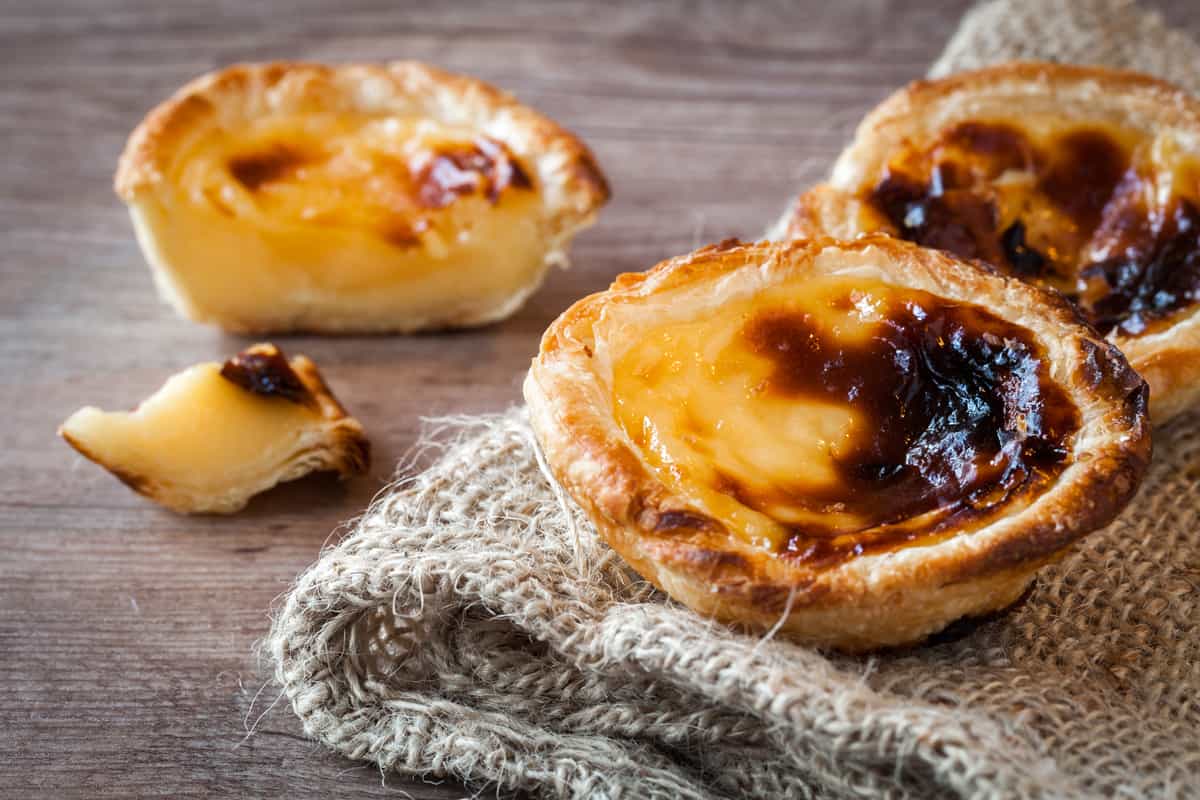
Be sure to also try my Broas Castelares (Portuguese Sweet Potato Cookies)!
Save This Recipe
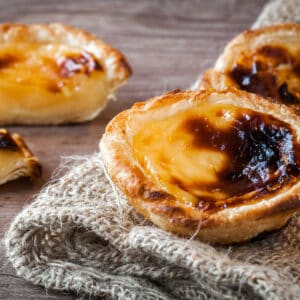
Pastéis de Nata (Portuguese Custard Tarts)
Ingredients
- 1 pound puff pastry , click link for easy homemade rough puff pastry recipe
- For the Custard:
- 2/3 cup water
- 1 1/4 cup granulated sugar
- 1 large cinnamon stick
- rind of one large lemon , cut into wide strips
- 1 1/4 cup whole milk
- 1/4 cup all-purpose flour
- 1/4 teaspoon salt
- 6 large egg yolks
- 1 teaspoon quality pure vanilla extract
Instructions
- Make the Custard:Place the water, sugar, cinnamon and lemon rind in a medium saucepan and bring it to a boil. Reduce the heat to medium and let it simmer – without stirring – until it reachers 220 degrees F on an instant read thermometer.Remove from the heat and let it cool for at least 15 minutes while you prepare the rest of the ingredients.In a separate medium saucepan scald the milk (heat until up to the boiling point but don't let it boil). Turn off the heat and add the flour and salt to the hot milk and whisk constantly until the mixture is nice and thick. Add the egg yolks and whisk until combined. Whisk in the vanilla extract.Remove the cinnamon and lemon rind from the syrup. In a thin, steady stream pour the syrup into the egg/flour mixture, whisking constantly. The custard will be very thin, this is normal.Pour the custard through a fine mesh sieve to strain out any chunky bits.Cover the bowl with plastic wrap and set aside until ready to use. You can make this in advance and refrigerate for up to 3 days.
- Prepare the Pastry Dough:On a lightly floured work surface, roll the pastry dough out to roughly a 11×14 inch rectangle. Beginning at the short end, roll up the pastry dough, rolling it tightly as you go along. Wrap the pastry roll in plastic wrap and refrigerate for at least 2 hours.
- Assemble the Tarts:Preheat the oven to the highest temperature it will go (I heated mine to 525 degrees F). Use a pastry cutter or sharp knife to cut the pastry log into about 3/4 inch thick rounds. (Cut a thin layer off each end and discard.)Use a standard size nonstick muffin pan. Depending on how full you fill the tarts this recipe makes about 16 tarts so you may need a second muffin pan.Place a pastry round in each tin. Use your thumbs to press the pastry down and up the sides to the very top to fit the mold. Pour the prepared custard into each pastry case to about 3/4 of the way full. Don't fill them too full or the custard will overflow onto the rims of the tart crusts. Place the pan on the middle rack of the preheated oven.Depending on the max temperature of your oven, bake for about 14-16 minutes (my oven was set to 525 degrees F). You'll know the tarts are done when the tops are nicely scorched and the filling is set. Remove from the oven and let the tarts cool for about 8-10 minutes before removing them. Serve with a dusting of powdered sugar and a small pinch of cinnamon if desired. These pastries are best eaten warm the same day they are baked.
Nutrition
Custard adapted from Leite’s Culinaria
Originally published on The Daring Gourmet December 22, 2020



















No lemon or lemon peel in original Portuguese recipes, the rest is good
Looks really good — have not tried it yet, though.
How would you adjust the puff pastry if you wanted to make these in smaller mini muffin tins? What would be the thickness of the pastry cuts, approx. yield and bake time? I tried them in Portugal this spring and preferred them with a smaller amount of custard to shell ratio.
Thanks!
This was my first attempt at any tart. I did not spread the pastry out enough so they were undercooked. I did a second batch and really made the sides and bottom very thin and lowered the temperature to 500 and baked for 15 mins. They were delicious. Anyone who says this recipe is no good cannot bake.
Wonderful, Ben! I’m so glad you didn’t give up after the first attempt and that the second attempt was such a success. So glad you enjoyed these, thank you for the feedback!
Wonderful, Ben! I’m so glad you didn’t give up after the first attempt and that the second attempt was a success. I’m thrilled you enjoyed these, thank you for the feedback!
Just made them ,turned out perfect and tasty following thus recipe. Will make again,bought puff pastry at store also got 18 perfect size tarts in muffin tins.
Please give measurements especially oven temperatures in centigrade as well
Hi Carmel, they’re all in the recipe box after the step-by-step preparation pictures.
Just google to measure from F to C. There are easy charts.
My filling overboils, making a mess. Can someone give advise on how to prevent this? They are delicious, but it is sad to lose the yummy filling, and makes much harder to unmold the pasteis.
I make a cream cheese stuffed muffin that is much easier to make and similar, Does not have the crispy pastry.
I wouldn’t recommend using a non-stick muffin tin over 450F. The coating starts to deteriorate at that point and can be a health risk.
My dough came out raw at the bottom. My pan is the same size but it’s a darker color, not light aluminum Ike your. I wonder if effects different heat hold.
Comments from people who have not tried the recipe are not helpful.
Reminds me of Portugal and my husband s family, sweet memories.
Recipe Not very good on some specifics. For example “ Add the flour and salt and whisk constantly until the mixture is nice and thick. Add the egg yolks and whisk until combined. ”. Is this done over continued heat, or not, after scalding the milk. My custard didn’t conceal well and puff up so I suspect it was undercooked. Also didn’t scorch so overcooked pastry waiting for custard to brown.
YUM!!! I cannot wait to give these a whirl! I have not attempted pasties before. I am excited!
Looks so delicious. I’m sure my family will love this one!
Yummy! These look so delicious and tasty! My family is sure to love this recipe! Can’t wait!